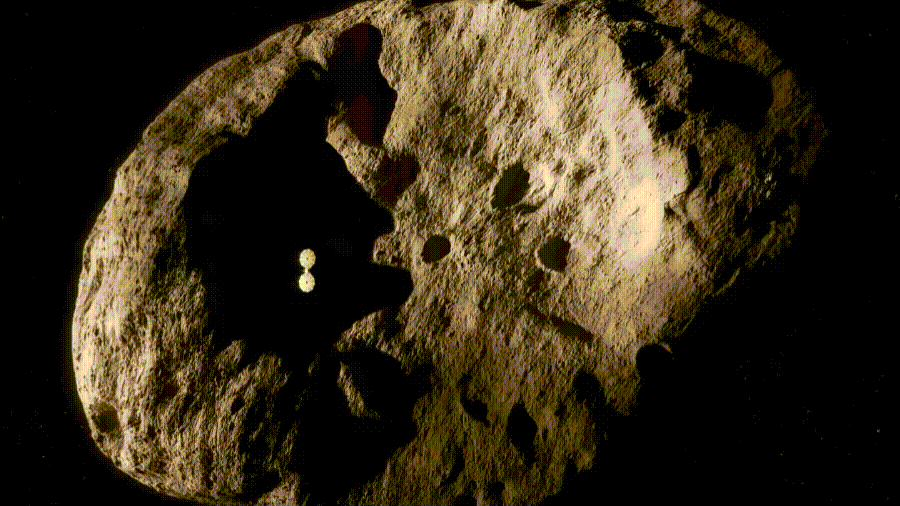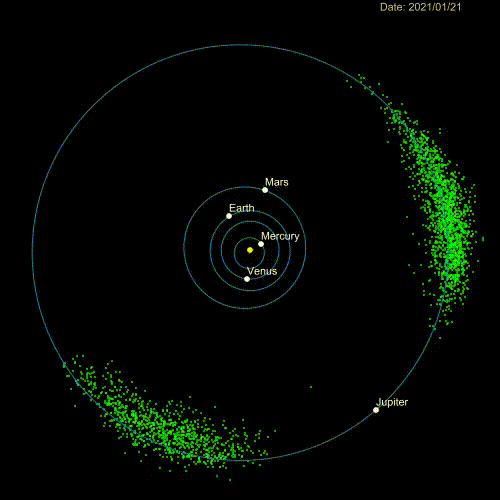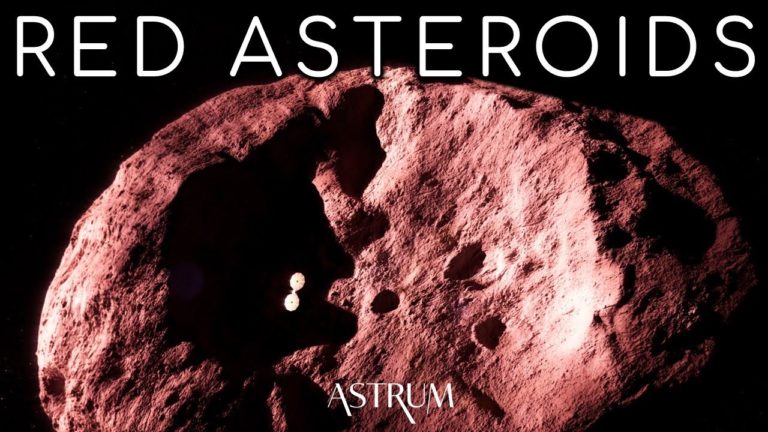NASA’s Next Big Mission: Lucy and Jupiter’s Red Trojan Asteroids
An ambitious mission to seven worlds in orbit around Jupiter begins Saturday. Here’s what you need to know.

NASA’s Goddard Space Flight Center
NASA is no stranger to the solar system’s most mammoth planet, the gas giant Jupiter. Robotic explorers, like Juno, have gazed upon its Great Red Spot and analyzed its atmosphere. But in its planetary neighbourhood lies a collection of ancient rocks known as the Trojan asteroids. These rocks are fossils from the earliest era of our solar system, time capsules locked in a dance around the sun, but we’ve never studied them up close. That’s about to change.
Next week, NASA is sending the Lucy spacecraft toward these ancient raw materials in an ambitious and daring decade-long mission to access our solar system’s well-preserved history.
Perfectly named for the fossil that taught us about humanity’s genesis, Lucy’s 12-year-long trek promises to reveal a cosmic evolutionary record. The spacecraft will catch closeup views of a diverse selection of Trojan asteroids to help scientists decipher how and why our solar system’s planets came to be.
Right now, we know close to nothing about these primitive rocks’ properties. But we’ve rounded up everything we can to help you prepare for the momentous launch.
How to watch NASA launch the Lucy mission
You can watch the lift-off, currently scheduled for Oct. 16 at 2:34 a.m. PT (5:34 a.m. ET), online on NASA TV.
Here’s that time around the world:
Saturday, Oct. 16
- USA: 2:34 a.m. PT / 5:34 a.m. ET
- Brazil: 6:34 a.m. Rio
- UK: 10:34 a.m.
- South Africa: 11:34 a.m.
- Russia: 12:34 p.m. (Moscow)
- UAE: 1:34 p.m.
- India: 3:04 p.m.
- China: 5:34 p.m.
- Japan: 6:34 p.m.
- Australia: 8:34 p.m. AEDT
While you wait, let’s dive into why this mission could be world-changing for astronomers.
What are the Trojan asteroids?
Long before planets came into existence, the solar system overflowed with trillions of rocky and icy bodies orbiting a dim sun. Some of these fragments slowly fused together to form larger planets, such as the Earth and Mars. But along the way, a bunch of floating rocks were left over.
Many were swept into the endless depths of the universe — taking their secrets with them — but a smattering still live in the outer reaches of our solar system.
Caught between the gravitational pull of the sun and of Jupiter are these primitive pieces of rock that have been around for billions of years. They’re known as Jupiter’s Trojan asteroids. NASA aptly refers to them as “time capsules from the birth of our solar system,” and they form two clusters that share an orbit with the gas giant. Over 7,000 have been detected so far.
“The stuff that went into growing Jupiter and Saturn are now trapped in these locations,” NASA planetary scientist and principal investigator of the Lucy mission, Hal Levison, said in the mission’s overview.
Where does Lucy come in?
Lucy will be the first spacecraft to asteroid-hop among seven of the Trojan asteroids, but before heading to both the leading and trailing swarms, it’ll visit a main belt asteroid located between Mars and Jupiter.

NASA
“We’re going to eight never-before-seen asteroids in 12 years with a single spacecraft,” Tom Statler, Lucy project scientist at NASA headquarters in Washington said in a statement. “This is a fantastic opportunity for discovery as we probe into our solar system’s distant past.”
NASA notes that “no other space mission in history has been launched to as many different destinations in independent orbits around our sun” and that “Lucy will show us, for the first time, the diversity of the primordial bodies that built the planets.”
The spacecraft will use traditional chemical propulsion technology that’ll help with maneuvering, but to save fuel, it’ll fly past points of interest instead of treading slowly. That doesn’t pose much of a hindrance, though, because Lucy can still snap pics and collect spectroscopic information while whizzing by.
Mission objectives
Armed with a high-gain antenna for communication with Earth; high-tech cameras (color, as well as black and white); an infrared spectrometer and thermometer, the spacecraft will check out several key features of these asteroids by capturing their physical properties:
Surface geology: This includes things like shape, crater size, crustal structure and layering.
Surface color and composition: Tones and colors of the rocks, mineral makeup and regolith properties, such as loose soil composition, are some of these features.
Interiors and bulk properties: Masses, densities, powder blankets around craters and other nitty gritty details comprise this section.
Satellites and rings: A few of the asteroids might have mini-asteroids orbiting them, as though they’re the center of their own solar system. Some might even have Saturn-like rings consisting of super-small rocks or icy bodies.

Lockheed Martin
Prepping for take-off
It isn’t easy being a NASA probe.
Because Lucy will rely on solar power for the mission, its arrays — large enough to cover a five-story building — had to undergo intense testing to ensure they won’t malfunction during spaceflight. They’re so huge because of how far the probe will be traveling from the sun.

Lockheed Martin
According to NASA, it will take a total of 20 minutes for these crucial solar panels to extend after launch. “These 20 minutes will determine if the rest of the 12-year mission will be a success,” Levison said in a statement.
Mars rovers, such as Perseverance, have shorter spans of anxiety-inducing moments during their EDL phase, or entry, descent and landing sequence.
“Mars landers have their seven minutes of terror, we have this,” Levison remarked.
After several iterations of testing, Donya Douglas-Bradshaw, Lucy project manager from NASA’s Goddard Space Flight Center in Greenbelt, Maryland, said in a statement that the execution on the ground was “flawless.”
Although space is a very different arena.
On Oct. 16, Lucy will be transported to the Vehicle Integration Facility at the Cape Canaveral Space Force Station and “mated” with the United Launch Alliance Atlas V rocket. That rocket will help Lucy exit Earth’s atmosphere.
Then, Lucy will propel away from our home planet to begin the 12-year voyage, swinging around the solar system, using Earth’s gravity as leverage three times during the journey.
“Launching a spacecraft is almost like sending a child off to college — you’ve done what can for them to get them ready for that next big step on their own,” Levison said.

Lockheed Martin
What will happen after the mission is complete?
After a dozen years, Lucy will stabilize near Earth, then crusade once again to the Trojan asteroid belt. It’ll be the first ever spacecraft to travel all the way to Jupiter and back home.
Future humans will face two options: collect Lucy as an artifact and bring it down to Earth, or allow Jupiter to eventually fling it into the sun or out of the solar system.
Not to fear. Lucy’s job will be complete by then. And perhaps our astronomy textbooks will be amended with the unprecedented information it delivers home.
Do not forget to share your opinion with us to provide you with the best posts !




0 Comments